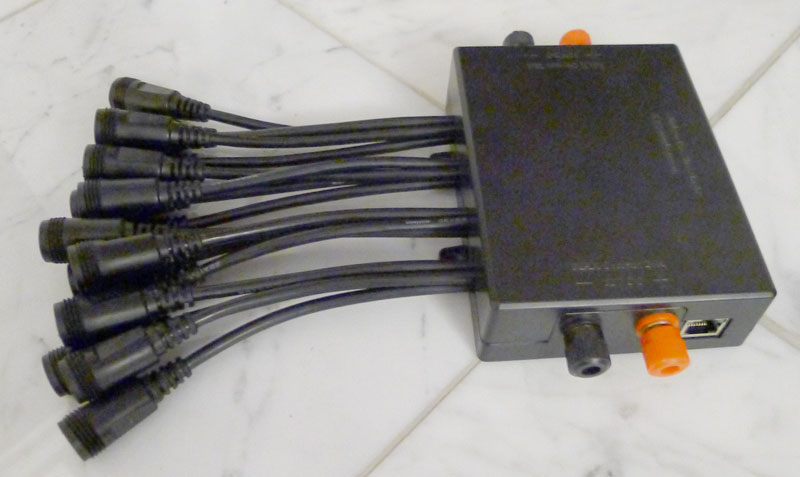Data Distribution board (DD16)
Data Distribution board (DD16)
The DD16 distributes power and data from the Effects Controller, to individual light strings. The case is 5.25 x 4 x 1.4 inches, and includes four screw tabs for mounting.

Hardware
The DD16 requires 9-12vdc (normally 12vdc) on its power input pins (RED POSITIVE and BLACK NEGATIVE). Reversing polarity will destroy the device any possibly any light strings connected to it! There are power inputs on both sides of the case that are internally connected. Each side connection can handle about 15-20A, so if you need over that, split the incoming power to both sides of the case.
Power can be calculated as approximately 0.03A times the number of lights connected to the DD16. For example, 1000 lights times 0.03A would require a 12vdc, 30A power supply.
Control is via an RJ45 jack implementing the DMX RJ45 standard pinout (pin 1 D+, pin 2 D-, pin 7 and 8 Ground). Normally you would connect a standard CAT5 type cable from the DD16 to ports 1-4 of the Effects Controller.
The DD16 has 16 output ports for connection to light strings. Ports should be used in order starting with #1.
DD16 XDMX Protocol
The DD16 normally uses an enhanced version of DMX we call XDMX (eXtreme DMX). This is basically the DMX protocol running at 4 times the speed (1Mb) and with larger packet sizes. It also uses special commands to configure the DD outputs for the correct number of lights and strings.
DD16 DMX Protocol
The DD16 can be used in a DMX compatible way, but it will be severely limited. If any jumpers are installed on the circuit board (PCB) in positions J2-7 (by soldering a wire across the two holes for each jumper), then the board will revert to standard DMX mode (250Kb speed). The DD16 uses the entire DMX packet as RGB data to send to the light strings. The jumpers define how many lights are on each string. J2-7 form a binary number with J2 being the highest order bit and J7 the lowest. This number is multiplied by 2 and then added to 4 to set the number of lights. For example:
J7 jumpered = 1. (1 * 2)+4 = 6 lights per string.
J5,J7 jumpered = 5. (5 * 2)+4 = 14 lights per string.
J4 jumpered = 8. (8 * 2)+4 = 20 lights per string.
J4,J6 jumpered = 10. (10* 2)+4 = 24 lights per string.
J2 jumpered = 32. (32* 2)+4 = 68 lights per string.
J2-7 jumpered = 63. (63* 2)+4 = 130 lights per string.
J7=1,J6=2,J5=4,J4=8,J3=16,J2=32
BACK TO TOP

